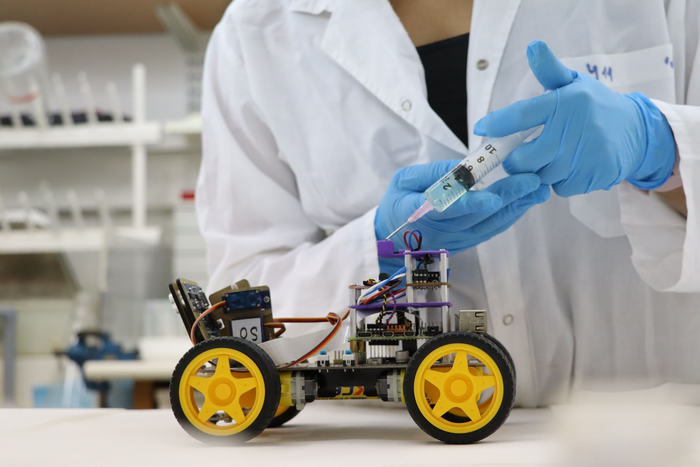Reviewed by Alex SmithJan 18 2023
It is possible for a robot to smell with the help of a biological sensor. This finding is the result of a new technological development made at Tel Aviv University. The sensor transmits electrical signals as a response to a nearby odor, which could be detected and interpreted by the robot.

The robot with the biological sensor. Image Credit: Tel Aviv University.
In this study, scientists successfully linked the biological sensor to an electronic system. Using a machine learning algorithm, they could determine odors with a level of sensitivity that is 10,000 times higher than that of a commonly utilized electronic device.
The scientists believe that considering the success of their research, this technology might also be utilized in the future to find drugs, diseases, and explosives.
The biological and technological discovery was headed by doctoral student Neta Shvil of Tel Aviv University’s Sagol School of Neuroscience, Dr Ben Maoz of the Fleischman Faculty of Engineering and the Sagol School of Neuroscience, and Professor Yossi Yovel and Professor Amir Ayali of the School of Zoology, and the Sagol School of Neuroscience.
The study outcomes were published in the renowned journal Biosensor and Bioelectronics.
Dr. Maoz and Professor Ayali explain,
Man-made technologies still can’t compete with millions of years of evolution. One area in which we particularly lag behind the animal world is that of smell perception. An example of this can be found at the airport where we go through a magnetometer that costs millions of dollars and can detect if we are carrying any metal devices.”
“But when they want to check if a passenger is smuggling drugs, they bring in a dog to sniff him. In the animal world, insects excel at receiving and processing sensory signals. A mosquito, for example, can detect a 0.01 percent difference in the level of carbon dioxide in the air. Today, we are far from producing sensors whose capabilities come close to those of insects.”
Scientists highlight that the sensory organs of humans like the ear, eye, and nose—as well as those of all other animals—make use of receptors that tend to determine and spot between different signals in general. Further, the sensory organ translates these outcomes into electrical signals, which the brain decodes in the form of data.
The problem with biosensors is in connecting a sensory organ, like the nose, to an electronic system that is aware of how to decode the electrical signals that the receptors receive.
We connected the biological sensor and let it smell different odors while we measured the electrical activity that each odor induced. The system allowed us to detect each odor at the level of the insect’s primary sensory organ.
Yossi Yovel, Professor, Tel-Aviv University
Yovel continued, “Then, in the second step, we used machine learning to create a ‘library’ of smells. In the study, we were able to characterize 8 odors, such as geranium, lemon, and marzipan, in a way that allowed us to know when the smell of lemon or marzipan was presented.”
“In fact, after the experiment was over, we continued to identify additional different and unusual smells, such as various types of Scotch whiskey. A comparison with standard measuring devices showed that the sensitivity of the insect’s nose in our system is about 10,000 times higher than the devices that are in use today,” added Yovel.
Dr. Maoz concludes: “Nature is much more advanced than we are, so we should use it. The principle we have demonstrated can be used and applied to other senses, such as sight and touch. For example, some animals have amazing abilities to detect explosives or drugs; the creation of a robot with a biological nose could help us preserve human life and identify criminals in a way that is not possible today. Some animals know how to detect diseases. Others can sense earthquakes. The sky is the limit.”
In research to be done in the future, the scientists plan to offer the robot a navigation potential to enable it to localize the odor source and, then, its identity.
Journal Reference:
Neta, S., et al. (2023) The Locust antenna as an odor discriminator. Biosensors and Bioelectronics. doi.org/10.1016/j.bios.2022.114919.